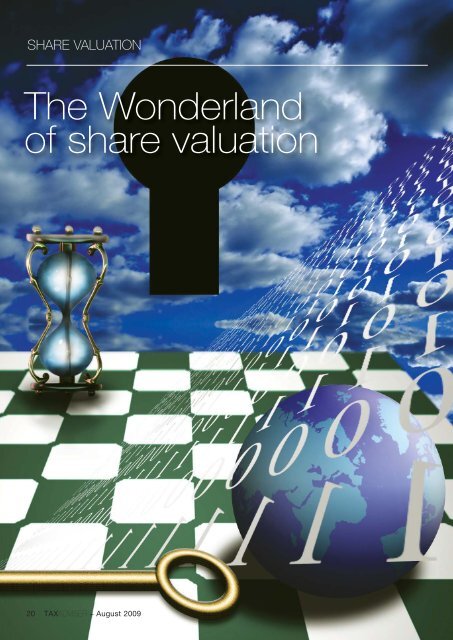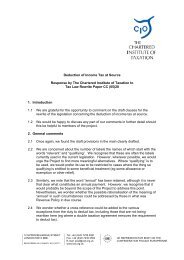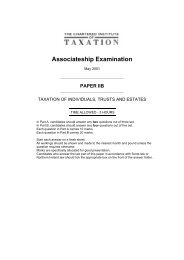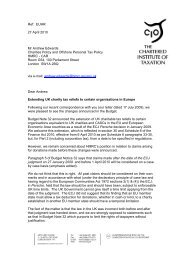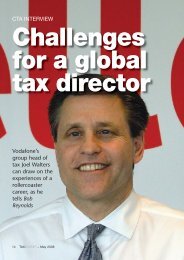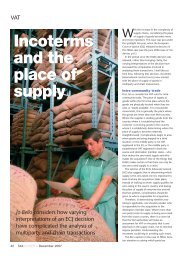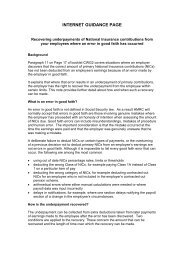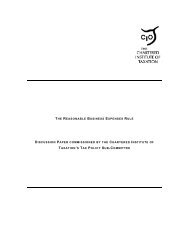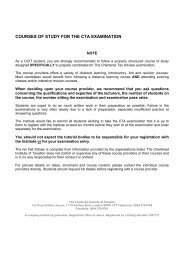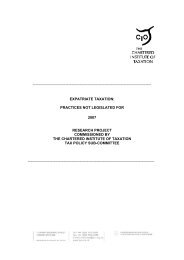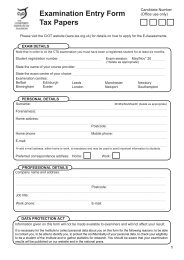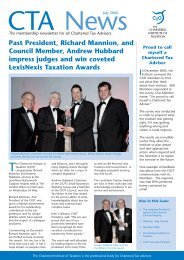The Wonderland of share valuation
The Wonderland of share valuation
The Wonderland of share valuation
You also want an ePaper? Increase the reach of your titles
YUMPU automatically turns print PDFs into web optimized ePapers that Google loves.
SHARE VALUATION<br />
<strong>The</strong> <strong>Wonderland</strong><br />
<strong>of</strong> <strong>share</strong> <strong>valuation</strong><br />
20 TAXADVISER – August 2009
SHARE VALUATION<br />
By 2003, the government had<br />
tired <strong>of</strong> what it perceived as<br />
large-scale tax avoidance by<br />
means <strong>of</strong> low-value <strong>share</strong>s and options<br />
made available to employees, a<br />
position it resolved to change when it<br />
enacted the wide ranging provisions <strong>of</strong><br />
FA 2003, Sch 22, including what is<br />
now Part 7 <strong>of</strong> ITEPA 2003. I cannot<br />
comment on the tax implications, but<br />
as someone who specialises in the<br />
<strong>valuation</strong> <strong>of</strong> <strong>share</strong>s for purposes that<br />
include employment-related securities,<br />
it seems to me that, as Alice in<br />
<strong>Wonderland</strong> might have put it, these<br />
days one doesn’t know what is and<br />
what isn’t.<br />
<strong>The</strong> previous <strong>valuation</strong> rules had<br />
been with us for many years, and were<br />
reasonably well understood. Employees<br />
Salmon, Patrick v Burrows, and Ede v<br />
Wilson and Cornwall, 2 and depended on<br />
what the <strong>share</strong>s were worth to the<br />
actual recipient rather than some<br />
anonymous acquirer, which meant that<br />
personal characteristics, and<br />
information actually known by the<br />
recipient, were to be taken into<br />
account.<br />
Occasionally, the different <strong>valuation</strong><br />
approaches would produce different<br />
results. In one case where <strong>share</strong>s were<br />
issued to both shop-floor workers and<br />
management, a higher value applied to<br />
the management <strong>share</strong>s because they<br />
were aware <strong>of</strong> an <strong>of</strong>fer for the company,<br />
while most members <strong>of</strong> the workforce<br />
were not. In most cases, however, there<br />
would be very little, if any, difference in<br />
value, whichever basis applied, but<br />
on principles consistent with the<br />
requirements <strong>of</strong> ICTA, s. 19, the<br />
so-called ‘normal rules charge’, and<br />
Weight v Salmon etc remain in force.<br />
Part 7 <strong>of</strong> ITEPA deals with<br />
‘Employment Income: Income and<br />
Exemptions relating to Securities’,<br />
which would seem to comprise a ‘pr<strong>of</strong>it<br />
or incidental benefit <strong>of</strong> any kind<br />
obtained by the employee if it is money<br />
or money’s worth’ referred to in<br />
s. 62(2) above, and includes<br />
employment-related securities. Section<br />
421 in Part 7, Chapter 1 clearly states<br />
that in Chapters 1-5 <strong>of</strong> Part 7, ‘market<br />
value’ has the same meaning as it has<br />
for the purposes <strong>of</strong> Part 8 <strong>of</strong> the TCGA,<br />
ie, TCGA, s. 272. <strong>The</strong>refore, it would<br />
seem that, while employee <strong>share</strong>s are<br />
valued under s. 62 on the money’s<br />
David Bowes examines some <strong>of</strong> the <strong>valuation</strong> issues that have emerged as<br />
a consequence <strong>of</strong> the changes to the employee <strong>share</strong>s regime<br />
who received rights or interests in<br />
<strong>share</strong>s, usually options, would pay<br />
income tax on the ‘market value’ <strong>of</strong> the<br />
underlying <strong>share</strong>s, defined by what is<br />
now TCGA 1992, s. 272, less any price<br />
paid. Market value envisages a sale in<br />
the open market between hypothetical,<br />
willing, anonymous, parties. While<br />
rights and restrictions contained in the<br />
relevant company’s articles <strong>of</strong><br />
association would be taken into<br />
account, <strong>share</strong>holders’ agreements or<br />
other personal or collateral agreements<br />
were ignored. 1 In general terms, for<br />
minority holdings <strong>of</strong> such <strong>share</strong>s, the<br />
information to be taken into account in<br />
the <strong>valuation</strong> is published information<br />
only.<br />
If employees actually received <strong>share</strong>s<br />
by reason <strong>of</strong> their employment, the<br />
Schedule E charge to tax arose under<br />
TA 1988, s. 19 and s. 131. Market value<br />
was nowhere mentioned in the<br />
legislation, and any tax was due on the<br />
difference between the ‘money’s worth’<br />
<strong>of</strong> the <strong>share</strong>s, and what the employee<br />
paid for them, if less. Money’s worth<br />
was determined in accordance with the<br />
decisions in cases such as Weight v<br />
most importantly, there was relative<br />
certainty as to which one would apply,<br />
and what the consequences would be<br />
in <strong>valuation</strong> terms.<br />
ITEPA 2003 – plus c’est la<br />
même chose<br />
FA 2003, Sch 22 changed all that.<br />
Income tax is now chargeable under<br />
ITEPA 2003, s. 6 on employment<br />
income, stated in s. 7 to include<br />
‘earnings’ within ITEPA, Part 3, Chapter<br />
1, which in fact comprises only one<br />
section, s. 62, and which purports to<br />
explain what is meant by earnings ‘in<br />
the employment income Parts’,<br />
presumably Parts 2-7 <strong>of</strong> ITEPA. Such<br />
‘earnings’ include ‘any gratuity or other<br />
pr<strong>of</strong>it or incidental benefit <strong>of</strong> any kind<br />
obtained by the employee if it is<br />
money or money’s worth’ in<br />
accordance with Chapter 1, Part 3.<br />
Money’s worth is defined by s. 62(3) as<br />
something either ‘<strong>of</strong> direct monetary<br />
value to the employee, or capable <strong>of</strong><br />
being converted into money or<br />
something <strong>of</strong> direct monetary value to<br />
the employee’. That suggests that the<br />
basic income tax charge seems to arise<br />
worth basis, as is the position with<br />
other non-monetary assets, they also<br />
confusingly fall within the s. 272 basis<br />
because <strong>of</strong> the requirements <strong>of</strong> Part 7.<br />
ITEPA 2003 – plus ça change<br />
Part 7 disconcertingly creates this<br />
previously unknown asset – the<br />
‘restricted’ security or interest in<br />
securities (s. 423) – and also seems to<br />
require determination <strong>of</strong> its value under<br />
s. 272. Restrictions on <strong>share</strong>s are<br />
something that valuers have been very<br />
familiar with for as long as private<br />
companies have existed. After all, many<br />
companies subject their <strong>share</strong>s to them<br />
in their Articles <strong>of</strong> Association.<br />
However, in Part 7, if as a result <strong>of</strong> the<br />
restrictions the value is less than it<br />
would be but for them, all restrictions,<br />
whether the subject <strong>of</strong> any contract,<br />
agreement, arrangement or condition,<br />
have to be taken into account in<br />
valuing these restricted <strong>share</strong>s. Despite<br />
the fact that, in determining the<br />
market value <strong>of</strong> restricted securities, s.<br />
421 prescribes the market-value basis,<br />
that brings into the equation all<br />
limitations imposed by the personal<br />
TAXADVISER – August 2009 21
SHARE VALUATION<br />
SAV seems to have found a solution to the problem<br />
created by this very complicated piece <strong>of</strong> legislation<br />
and collateral agreements referred to in<br />
the third paragraph above, which are<br />
normally excluded from consideration<br />
under s. 272.<br />
ITEPA 2003 – down the<br />
rabbit hole<br />
So the question is – are we valuing<br />
under s. 62 or s. 272? It appears that<br />
Shares and Assets Valuation <strong>of</strong> HMRC<br />
(SAV) think we are under s. 272 because<br />
in effect they have told us so. In<br />
response to FAQ1(K), namely, ‘Market<br />
value is now based on the CGT<br />
definition. Does this mean that personal<br />
restrictions on the <strong>share</strong> no longer have<br />
to be taken into account in arriving at its<br />
value?’ HMRC said: ‘No. Even where<br />
there is, for example, a restriction on<br />
sale, the <strong>share</strong>s must be valued as if that<br />
restriction would still apply to their<br />
hypothetical purchaser. It is the asset (as<br />
it is) that is being valued, not some<br />
other unrestricted asset.’ <strong>The</strong><br />
hypothetical purchaser does not exist<br />
except for <strong>valuation</strong>s under s. 272, so<br />
seemingly we are valuing on the basis <strong>of</strong><br />
a sale to a hypothetical purchaser who<br />
may have to submit to personal<br />
restrictions imposed on someone else.<br />
To add to the confusion, in order to<br />
obtain CGT treatment <strong>of</strong> any future<br />
disposal proceeds, <strong>share</strong>holders can<br />
elect under s. 431, resulting in tax being<br />
paid when the <strong>share</strong>s are acquired on<br />
the value presuming that the restrictions<br />
do not apply – the unrestricted market<br />
value (UMV). As s. 431 is within Part 7,<br />
and clear reference is made thereto on<br />
that section, it seems that s. 272 must<br />
also apply in determining UMV. We<br />
therefore have the almost completely<br />
contradictory positions, namely that for<br />
restricted <strong>share</strong>s under s. 272 we have<br />
regard to otherwise irrelevant<br />
restrictions, in arriving at what is<br />
somewhat erroneously described as<br />
actual market value (AMV), and for<br />
UMV, also under s. 272, we completely<br />
disregard the existence <strong>of</strong> any<br />
restrictions at all.<br />
And what, in the meantime,<br />
happened to the money’s worth<br />
<strong>valuation</strong> test in s. 62, seemingly<br />
usurped by market value in Part 7? <strong>The</strong><br />
reports <strong>of</strong> its death seem to have been<br />
greatly exaggerated. <strong>The</strong> Share Schemes<br />
Manual at 70210 states that ‘normally<br />
the money’s worth and the market value<br />
per TCGA92/s. 272 will be the same.<br />
Where market value exceeds money’s<br />
worth value there can be an additional<br />
charge under Chapter 3C on the<br />
excess’. <strong>The</strong> Shares Valuation Manual at<br />
109030 states that: ‘In practice most<br />
employers and employees elect out <strong>of</strong><br />
the money’s worth basis <strong>of</strong> <strong>valuation</strong> for<br />
a full UMV. Where the UMV is seemingly<br />
less than the money’s worth value, the<br />
case should be referred for advice.’ <strong>The</strong><br />
implication <strong>of</strong> that seems to be that the<br />
money’s worth basis takes precedence,<br />
unless the market value, namely the<br />
alternative one that ignores all<br />
restrictions, is greater.<br />
Curiouser and curiouser<br />
If all restrictions are to be regarded,<br />
including personal ones, perhaps that<br />
could only really be achieved using the<br />
money’s worth basis. It would follow<br />
that this basis might apply for the AMV<br />
<strong>of</strong> restricted <strong>share</strong>s, notwithstanding<br />
the apparent application <strong>of</strong> the s. 272<br />
value instead, although some<br />
illogicalities might then arise. While the<br />
legislation is aimed at restrictions, the<br />
money’s worth basis also embraces<br />
<strong>share</strong>holders’ rights. If the particular<br />
recipient had inside information<br />
relating to the company’s future<br />
prospects, for example, that could<br />
result in the restricted <strong>share</strong>s being<br />
worth more than on a s. 272 basis,<br />
surely not what was intended.<br />
According to the Share Schemes<br />
Manual 220020, the position is as<br />
follows: ‘<strong>The</strong> charge on acquisition <strong>of</strong><br />
securities is still <strong>of</strong>ten the money’s worth<br />
charge under ITEPA, s. 62, unless an<br />
election under s. 431 is made for the<br />
unrestricted market value to apply…..<br />
Where restricted securities are involved,<br />
the unrestricted market value will usually<br />
be higher than the money’s worth or<br />
CGT values, which take account <strong>of</strong> the<br />
restrictions.’<br />
As already stated, normally the<br />
money’s worth and the market value will<br />
be the same, but according once more<br />
to the Share Schemes Manual at 20510,<br />
where they differ, any additional value<br />
over and above the money’s worth value<br />
is chargeable under Chapter 3C <strong>of</strong> Part<br />
7, which is concerned with securities<br />
acquired for less than market value, and<br />
is a sweeping-up provision. Accordingly,<br />
most other provisions take priority over<br />
it, including a money’s worth charge,<br />
unless the amount charged under<br />
Chapter 3C would be greater than that<br />
charged under any <strong>of</strong> those provisions,<br />
in which case the excess is chargeable<br />
under Chapter 3C.<br />
Through the keyhole<br />
As stated at the outset, before ITEPA, we<br />
seem to have had two <strong>valuation</strong> bases.<br />
<strong>The</strong> money’s worth basis applied only<br />
for Schedule E. Market value, whether<br />
under s. 272 or s. 160 for IHT, applied<br />
for everything else. Notwithstanding the<br />
references in ITEPA Part 7 to market<br />
value, as understood for almost all other<br />
tax purposes it does not seem to apply<br />
for employment purposes. Instead,<br />
there now seem to be two new assets,<br />
unrestricted <strong>share</strong>s to be valued<br />
ignoring all restrictions whatsoever, and<br />
restricted ones that are valued subject<br />
to all possible ones.<br />
At least SAV seems to have found a<br />
solution to the problems created by this<br />
very complicated piece <strong>of</strong> legislation.<br />
Given the potential difficulties in valuing<br />
the fictional AMV, their solution has<br />
become one <strong>of</strong> using normal rules while<br />
paying heed to all the restrictions, thus<br />
arriving at a heavily discounted figure<br />
for AMV with which valuers would be<br />
reasonably comfortable, and adding a<br />
small premium thereto in order to arrive<br />
at UMV.<br />
A solution that is arguably certainly<br />
not beyond criticism in pure <strong>valuation</strong><br />
terms, it represents a pragmatic solution,<br />
preferable to the Mad Hatter’s tea party<br />
that it once threatened to become.<br />
David Bowes is a chartered tax adviser.<br />
He is a partner in Bruce Sutherland &<br />
Co, the <strong>share</strong> <strong>valuation</strong> specialists, and<br />
can be contacted at david.bowes@<br />
bruce-sutherland.com; 01608 651091<br />
1. A-G v Jameson [1905] 2 IR 218, IRC v<br />
Crossman 15 ATC 94, HL, Lynall, Re,<br />
50 ATC 347, HL, and others<br />
2. Weight v Salmon 14 ATC 47, HL,<br />
Patrick (Inspector <strong>of</strong> Taxes) v Burrows<br />
(1954) 35 TC 138, Ede v Wilson and<br />
Cornwall [1945] 1 All ER 367<br />
22 TAXADVISER – August 2009


